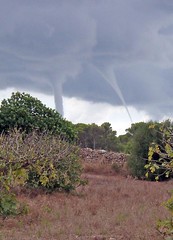Though I am more than happy to trade in my blue jeans and boots for shorts and flip-flops, not everything warm weather brings is welcome. As the Bemidji Pioneer reminds us, warm weather also brings tornado season.
For years, weather experts have been working on cutting-edge technology to detect tornados. But, when city sirens wail and weather warnings flash across the bottom of t.v. screens, people are generally slow to take cover. In fact, many studies have shown that people often spend time looking for more information about the potential tornado rather than hitting their basements. According to Dennis Mileti, a sociologist and retired director of the Natural Hazards Center at the University of Colorado in Boulder,
“People turn into information vampires when they hear their town and village might be struck by a violent tornado…And if you don’t provide them with the information they need, what you’re actually doing is guaranteeing the time people spend searching is longer rather than shorter.”
In addition, many people get into the mindset that the warning is “just another warning.” Tornado survivors are an exception, though, as they almost always respond more quickly to severe weather warnings. But, as Mississippi State University Sociologist Laura Myers explains, the rest of us don’t learn from their experience.
Myers found that about 10 percent of the population are anxious about bad weather and take shelter at the first sign of danger. But, most respond to dangerous situations like a tornado warning with what she calls denial. “They’re sitting there saying, ‘OK, I don’t want to deal with it. I don’t want to have to worry about it. I want to assume everything is going to be OK.’ That’s why the person will wait for that secondary confirmation. They’ll say, ‘I’ve really gotta know it’s going to hit me.’”
Related, many don’t respond due to the prevalence of false alarms. According to the National Weather Service, three out of four tornado warnings are false alarms. Social scientists believe that just explaining that these were false alarms (for example, that a tornado formed but didn’t touch down) would help; otherwise, people often think they are just mistakes.
Because of this, the weather service is making an effort to utilize the knowledge of social scientists in order to understand the impact of warning systems. This blending of physical and social science, combined with new technology and social media outlets, will change how tornado warnings reach us and, hopefully, save lives.


Comments 3
Sarah Shannon — May 17, 2012
Thanks for covering this. As a sociologist and a tornado survivor, I appreciate it!
David Scheuer — June 20, 2012
Interesting, and I appreciate how frustrating it must be for the forecasters and Public Safety folks. I will say, as someone who lived in NE Kansas for 20 years, that one other aspect to this, at least in tornado country, is that the audience is fairly sophisticated about twisters (really!). This is somewhat related to the 'false alarms' theory, but slightly different.
Now things may change with the more detailed radar and warnings that are just becoming available, but it's been my experience that many people in the prairie states are well aware that not all warnings are created equal. EF4s and 5s make up a tiny percentage of tornadoes, but the vast majority of deaths. If folks hear the phrase 'large, violent tornado', or more recently, 'debris ball', yes, they'll take cover immediately (well, most of them) but if they think it's 'just another funnel', not so much. My $.02, anyway.
Letta Page — June 30, 2012
Completely agree, David - I'm from the Midwest and got tornado drills both at school and at home (my father was a fireman). Now that I'm an adult and still live in the area, *I* still hanker for a small, windowless room when there's a tornado warning, but I see so many who still want to go outside to "observe" the storms. Anything above a watch puts me on edge, and a siren? Forget it. But the problem may be that the biggest, most destructive, most terrifying storms in our area in recent memory (in Waseca, Hugo, North Minneapolis, and downtown Minneapolis in recent years) were either late at night (when people were unlikely to know there were warnings afoot anyway) or so sudden that the sirens happened after the storms. It had the effect of scaring people more about tornados, but also making them less likely to believe that the warning system was in any way reliable.
I'm interested to see what work is coming out of U Delaware's Disaster Research Center, about which I just learned, as a recent article was penned by Eric Best, who works there (he wrote with his own set of warnings about upcoming financial disaster in realm of federal student loans over in thesocietypages.org/specials)